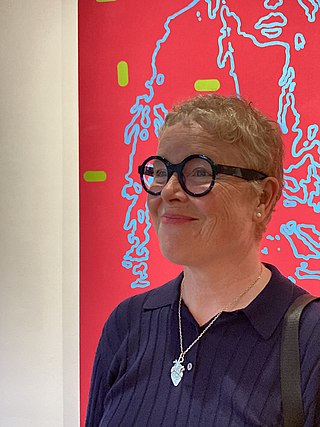Related Research Articles

The Université du Québec à Montréal, also known as UQAM, is a French-language public research university based in Montreal, Quebec, Canada. It is the largest constituent element of the Université du Québec system.

Jean-Paul Riopelle, was a Canadian painter and sculptor from Quebec. He had one of the longest and most important international careers of the sixteen signatories of the Refus Global, the 1948 manifesto that announced the Quebecois artistic community's refusal of clericalism and provincialism. He is best known for his abstract painting style, in particular his "mosaic" works of the 1950s when he famously abandoned the paintbrush, using only a palette knife to apply paint to canvas, giving his works a distinctive sculptural quality. He became the first Canadian painter since James Wilson Morrice to attain widespread international recognition.

Jean Paul Lemieux, was one of the foremost twentieth century painters in Canada. He worked in several different styles, as represented by his five artistic periods.
David Blatherwick (born 1960 in Toronto, Ontario) is a Canadian artist and educator.
Bill Vazan is a Canadian artist, known for land art, sculpture, painting and photography. His work has been exhibited in North America and internationally.

France Jodoin is a Canadian contemporary artist known for her maritime scenes. Painted in a semi-abstract style, her work is a modern interpretation of European Romanticism. Her work is found in Quebec museums, and in galleries in Canada, France and the United States.

Françoise Sullivan LL.D is a Canadian painter, sculptor, dancer, choreographer and photographer whose work is marked by her ability to switch from one discipline to another.

Jeanne Lapointe was a Canadian academic and intellectual.

Joanne Corneau, better known by the pseudonym Corno, was a Canadian artist from the Saguenay region of Quebec. She achieved international recognition for her large-scale paintings of women's faces and bodies in a "post-pop" style.

Henri Beau was a French-Canadian Impressionist painter. He is noted for Chemin en été, La dispersion des Acadiens, L'arrivée de Champlain à Québec, and Les Noces de Cana. Beau is a largely forgotten artist due to his long absence from Canada. His widow Marie Beau worked towards establishing his reputation as an artist in Canada after his death. He was only recognized as a notable artist decades later, with major retrospectives of his paintings celebrating his career by the Galerie Bernard Desroches in Montréal in 1974, and at the Musée du Québec in Québec City in 1987.
Anne Ramsden is a Canadian artist who has exhibited widely in Canada. She is currently based in Montreal, where she is a professor at the Université du Quebec à Montréal.

Michèle Lorrain is a Canadian artist specializing in painting and installation art.

Paryse Martin is an American-born Canadian artist. She works in multiple disciplines, including painting, sculpture, illustration and animation.
Claire Beaulieu is a Canadian artist. She works in the fields of painting, sculpture, installation and drawing.

Cynthia Girard-Renard, also known as Cynthia Girard, is a Canadian artist.
Chantal duPont (1942–2019) was a multidisciplinary Canadian artist based in Montreal. She worked in multimedia, photography, painting, sculpture, graphics and writing. For much of her career, she was an associate professor at the Université du Québec à Montréal. She is remembered in particular for her award-winning video art.

Francine Simonin was a Swiss-Canadian painter, engraver, and designer. She was considered to be an expressionist.
Fernande Saint-Martin was a Canadian art critic, museologist, semiologist, visual arts theorist and writer. A graduate of the Université de Montréal and McGill University, her career began at La Presse in 1954 before being made editor-in-chief of Châtelaine magazine in 1960. Saint-Martin left the magazine in 1972 and was made director of the Musée d'art contemporain de Montréal. She was a professor and researcher at Université Laval and later Université du Québec à Montréal from 1979 to 1996. Saint-Martin wrote several books and essays, contributed to various art publications and was awarded the Molson Prize in Humanities and Social Sciences from the Canada Council for her work in semiology in 1989. She was also president of the International Association for Visual Semiotics from 1990 to 1994.
Roméo Savoie DFA is a Canadian postwar and contemporary artist. One of the first abstract painters in Eastern Canada, the artist's body of work includes more than 4,000 paintings, 50 buildings, six poetry anthologies, and one novel.
Moses Reinblatt was a Canadian painter, printmaker, sculptor, and art teacher. He was associated with the Jewish Painters of Montreal.
References
- 1 2 "Artists in Canada". Canadian Heritage. Government of Canada. Archived from the original on 14 December 2018. Retrieved 12 December 2018.
- 1 2 "Resume | Christine Major | The Painting Project". The Painting Project. Université du Québec à Montréal. Retrieved 12 December 2018.
- ↑ "Description | Christine Major | The Painting Project". The Painting Project. Université du Québec à Montréal. Retrieved 12 December 2018.
- ↑ "Cuisine rouge | Christine Major | The Painting Project". The Painting Project. Université du Québec à Montréal. Archived from the original on 14 December 2018. Retrieved 12 December 2018.
- ↑ "Christine Major". www.collections.mnbaq.org. Retrieved 18 January 2020.
- ↑ "Her Story Today". Mutual Art. Retrieved 12 December 2018.
- ↑ "The Disorderless of Things". Mutual Art. Retrieved 12 December 2018.